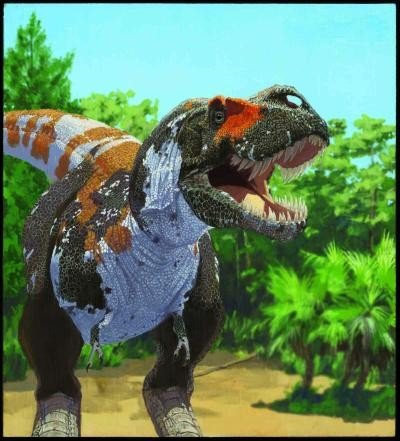Tyrannosaurus rex, shown in this artistic illustration, is part of the carnivorous groups of dinosaurs that researchers suggest maintained a stable level of biodiversity leading up to the mass extinction at the end of the Cretaceous. Credit: AMNH/J. Brougham
NEW YORK, May 1 (UPI) -- Some dinosaurs may have been on the way to extinction millions of years before an asteroid hit the Earth 65 million years ago, U.S. researchers say.
Scientists say their findings show that large herbivores -- plant-eating dinosaurs -- had been declining for 12 million years before the asteroid hit at the end of the Cretaceous period, although carnivorous dinosaurs and smaller plant-eating species were not, a release from the American Museum of Natural History reported Tuesday.
"Few issues in the history of paleontology have fueled as much research and popular fascination as the extinction of non-avian dinosaurs," said Steve Brusatte of the museum's Division of Paleontology.
"Did sudden volcanic eruptions or an asteroid impact strike down dinosaurs during their prime? We found that it was probably much more complex than that, and maybe not the sudden catastrophe that is often portrayed."
U.S. and European researchers looked at dinosaur extinction based on "morphological disparity" -- the variability of body structure within particular groups of dinosaurs -- whereas previous research was based almost exclusively on estimates of changes in the number of dinosaur species over time.
Dinosaur groups that showed an increase in variability might have been evolving into more species, giving them an ecological edge, researchers said, while decreasing variability might be a sign of extinction in the long term.
"People often think of dinosaurs as being monolithic -- we say 'The dinosaurs did this, and the dinosaurs did that,'" Richard Butler of Ludwig Maximilian University of Munich said. "But dinosaurs were hugely diverse. There were hundreds of species living in the Late Cretaceous, and these differed enormously in diet, shape, and size. Different groups were probably evolving in different ways and the results of our study show that very clearly."
The findings suggest several groups of large-bodied, bulk-feeding herbivores may have experienced a decline in biodiversity in the 12 million years before the dinosaurs ultimately went extinct, the researchers said.
"Contrary to how things are often perceived, the Late Cretaceous wasn't a static 'lost world' that was violently interrupted by an asteroid impact," Brusatte said. "Some dinosaurs were undergoing dramatic changes during this time, and the large herbivores seem to have been mired in a long-term decline, at least in North America."















